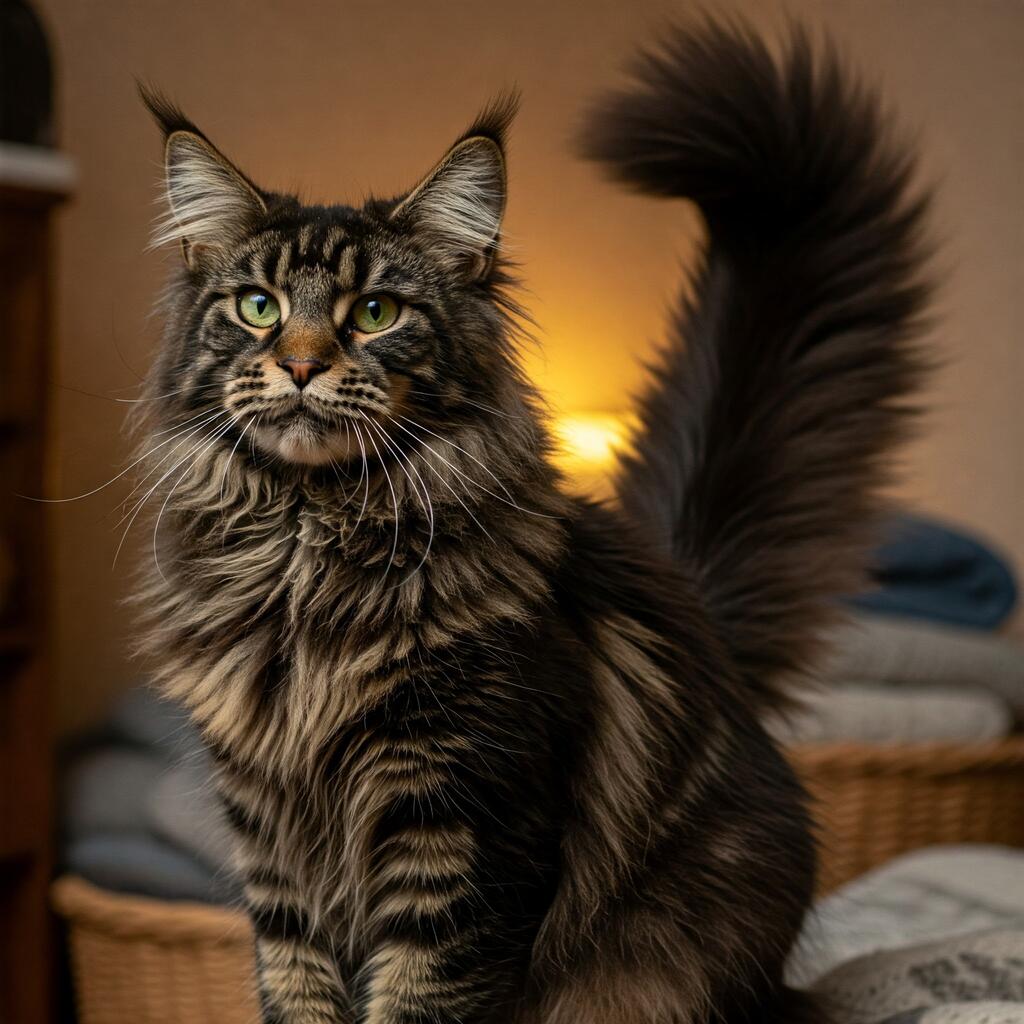
Maine Coon Cat Profile: Majestic & Friendly Feline
This is the cat breed with the largest tonnage. In fact, the males of the species can weigh up to 10 kilograms, while the females are around 7 kilograms. Their origin is not very clear and there are many legends concerning the very origin of this breed. Very picturesque legends, but without any objective proof.
The most widespread one says that because of its large, hairy ears and its large, ringed tail, the Maine Coon was the result of a cross between a lynx and a lavender bear. Another theory has it that the breed is descended from some French long-haired cats secretly sent to Maine by Marie Antoinette, shortly before her attempt to flee France, before she was condemned to the guillotine.
Yet another, due to their resemblance to the Norwegian Forest Cat, that they were brought by Viking ships that touched American shores some 1000 years ago. The most accredited theory, however, is that this breed is the result of careful mating between the common American Shorthair and long-haired cats of the Turkish Angora type and of a certain natural selection that favoured a large cat with a semi-long and thick coat, two adaptations to the cold and humid climate of Maine.
The Maine Coon was one of the first breeds to be recognised by the Governing Council of the cat fancy, which, at the beginning of the 19th century, was the largest organisation responsible for registering cat pedigrees and became one of the most prestigious breeds.
With the gradual appearance of more exotic breeds such as Persians and Cat Turkish Angora in the country, this breed was almost forgotten, even being said to have been declared extinct in the 1950s. Fortunately, this was only an exaggeration and this breed has now fully regained its glory, being recognised as an official breed in 1967 by the Canadian Cat Association.
Today's Maine Coons are very different from the first subjects bred; they are imposing, massive, enormous in size, some males weighing up to 14 kilograms, although their average weight is around 7 kilograms. Its body is long and well-proportioned in all its parts, muscular and with a broad chest.
It has high paws with richly furred toes so as not to sink into the snow, and even the ears, although large and wide open, have abundant tufts of hair. Its coat has a characteristic natural fat that protects it from atmospheric adversities. The eyes are large, expressive and oval-shaped, and it is not uncommon to find specimens with differently coloured eyes.
The coat of the Maine Coon is long, thick and somewhat untidy, shorter on the shoulders, longer on the stomach and on the front of the neck, the hair is soft and silky. The coat of this breed exists in all colour varieties with or without white, i.e., black, cream, blue and red.
The Maine Coon has a very calm character, very cuddly and playful. It is sociable and friendly, although with strangers it takes a while before it becomes affectionate. He has a very close relationship with his family and loves to follow the various members of the household in all their activities.
He is very curious and playful. therefore suitable for children, as he is very unlikely to scratch or blow. He gets along well with other cats and even with dogs. It is an extremely intelligent cat and is one of the few feline breeds that can be taught games such as bringing back a ball.
He appreciates a bit of freedom and is an excellent hunter, so if you have a garden, he will climb trees in search of some prey. In relaxed family moments, he loves to snuggle up close to a family member and even jump on his lap.
Maine Coons communicate not only with their body language and classic meows and purrs, but also with trill-like noises that are indeed a little strange coming from such an imposing cat.
The Maine Coon is a particularly robust, massive and muscular cat and does not require much care. However, the large amount of hair requires brushing at least once a week and during the moulting period twice.
A bath every two to three months is also recommended, precisely because of the thick, long coat. It is a cat that grows a lot and for a long time so it needs a varied diet that allows it to supplement its natural diet with supplements.
It does not tend to become obese, but it must be the owner's care to manage its needs correctly. Although he is a very robust animal, he may inherit some health problems that can be worrying: these include hypertrophic cardiomyopathy, hip dysplasia and spinal muscular atrophy.
Cardiomyopathy is the most common form of vascular disease in cats and causes thickening of the heart muscle. Hip dysplasia is a congenital defect of the hip joint. In mild cases it can cause no or little pain and in more severe cases it can lead to lameness. thus having difficulty moving and consequently moving slowly.
Spinal muscular atrophy is a disease that affects the nerve cells that transmit movement signals. This disease results in muscle weakening, but those affected can live a normal life as the disease does not cause them any pain even if they walk while swinging the back of their body.
These diseases are treated with special care by the breeders of this breed. For this reason, breeding animals are genetically tested and periodically monitored by echocardiographic examinations.
Some feline associations require up-to-date documentation of these tests and examinations for issuing the kittens' pedigrees. More careful breeders also subject their cats to other examinations, such as kidney ultrasounds and genetic tests such as SMA or PKdef. It is in the interest of the future owner to refer to serious and competent breeders in order to minimise the risk of these health problems.






















